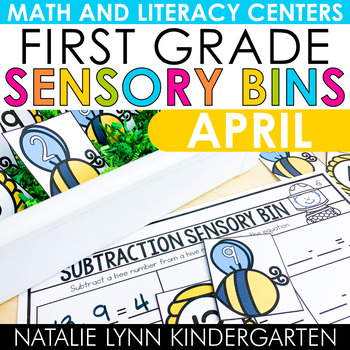April Sensory Bins 1st Grade Spring Math and Literacy Centers First Grade
- PDF
Also included in
- First grade teachers, are you looking for a fun, hands-on option for your monthly math and literacy centers? The 1st Grade Sensory Bins are it! Each month is packed with engaging and differentiated math and literacy centers your students will love.How do these first grade sensory bin centers work? JPrice $18.00Original Price $45.00Save $27.00
Description
First grade teachers, are you looking for a fun, hands-on option for your April math and literacy centers? These 1st Grade April Sensory Bin Centers are it! Your students will LOVE these meaningful April math and literacy centers (and you'll love how easy they are to use).
⭐Save BIG and get these in the First Grade Sensory Bins for the Year Bundle!
How do these first grade sensory bin centers work? Just print the cards on sturdy cardstock or laminate, cut out, and add to a sensory bin. Students will pull a card and record the answer on their recording sheet.
Wondering how to best set up your sensory bin? Check out this blog post --> How to Set Up Your Sensory Bin Centers
Many sensory bins contain multiple skills or recording sheets to offer options for differentiation! Please see the preview to see what skills each bin will cover.
April Sensory Bin Math and Literacy Centers:
Feed the Rabbits: Students will pick a carrot and color the matching word on their recording sheet. Skills included: ending blends, vowel teams, diphthongs
Sorting Sounds: Students will sort words according to their sounds. Skill: r-controlled vowels, vowel teams
Hopping for Words: Students will pick a lily pad and write the matching word on their recording sheet. Skills included: ending blends, r-controlled vowels, vowel teams
Past or Present Verbs: Students will pick a piece of litter and sort it by past or present verb tense. Skills included: past and present tense verbs.
Sight Words: Students will pick a sight word fish. They can color, write, or use the word in a sentence. Skill: high frequency words
Making Numbers: Students will choose a tens ladybug and a ladybug star to create a two-digit number. They will use that number on their recording sheet. Skills included: place value, expanded form, comparing numbers, counting on, adding double-digit numbers
I Can Tell Time: Students will pick a clock and write the corresponding time. Skills included: telling time to the hour and half hour
Counting Coins: Students will draw coins to match the values on the raindrops. Skills included: counting coins
Blooming for Addition and Subtraction: Students will choose 2-3 flower numbers and add them together. Skills included: addition within 10 or 20, adding 3 numbers, making a ten to add, number bonds, fact families, subtraction
Buzzing for Subtraction: Students will choose a beehive and a bee. They will subtract the bee number from the beehive number. Skills included: subtraction within 20
Make It True Equations: Students will choose a lily pad and decide which math symbol they need (+ or -) to make the equation true. Skills included: addition and subtraction, value of the equal sign
Double-Digit Addition: Students will pick two earth numbers and add them together by drawing base ten blocks to solve. Skills included: double-digit addition with and without regrouping






